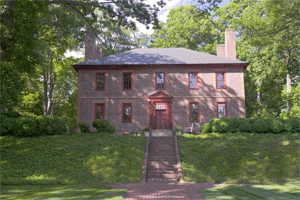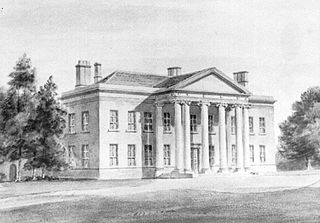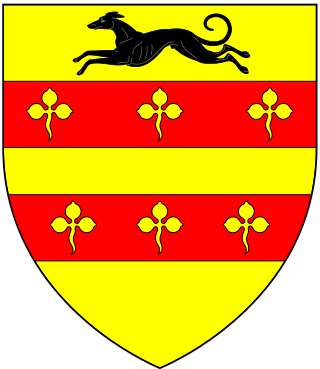
Earl of Chichester is a title that has been created three times, twice in the Peerage of England and once in the Peerage of the United Kingdom. The current title was created in the Peerage of the United Kingdom in 1801 for Thomas Pelham, 2nd Baron Pelham of Stanmer.

Penshurst Place is a historic building near Penshurst, Kent, 32 miles (51 km) south east of London, England. It is the ancestral home of the Sidney family, and was the birthplace of the great Elizabethan poets and courtiers, siblings Mary Sidney and Philip Sidney. The original medieval house is one of the most complete surviving examples of 14th-century domestic architecture in England. Part of the house and its gardens are open for public viewing. Many TV shows and movies have been filmed at Penshurst.

Stephen de Pencester was Warden of the Cinque Ports when the first authoritative list of Cinque Ports Confederation Members was produced in 1293.

John Sidney, 6th Earl of Leicester KB was an English soldier, peer, landowner, and courtier, and from 1705 to 1737 was Earl of Leicester, with a seat in the House of Lords.

Chiddingstone Castle is situated in the village of Chiddingstone, near Edenbridge, Kent, England, 35 miles south-southeast of London and in the upper valley of the River Medway. The castle was built by the Streatfeild family and served as their seat from the early 16th century until the beginning of the 20th century when the family left the castle. The Streatfeilds sold the castle to Lord Astor in 1938. Since 1977, the castle and its 35 acres of grounds have been held in trust for the nation by the Denys Eyre Bower Bequest, and both are open to the public. Much of the current structure dates from the early 19th century, but incorporates elements of the earlier buildings on the same site.

Chiddingstone is a village and civil parish in the Sevenoaks District of Kent, England. The parish is located on the River Eden between Tonbridge and Edenbridge. The villages of Chiddingstone Causeway and Bough Beech and the hamlet Chiddingstone Hoath are also included in the parish.

Penshurst is a historic village and civil parish located in a valley upon the northern slopes of the Kentish Weald, at the confluence of the River Medway and the River Eden, within the Sevenoaks district of Kent, England.

Wilton House Museum is a museum in a historic house located in Richmond, Virginia. Wilton was constructed c. 1753 by William Randolph III, son of William Randolph II, of Turkey Island. Wilton was originally the manor house on a 2,000-acre (8.1 km2) tobacco plantation known as "World's End" located on the north bank of the James River several miles east of the city of Richmond. Between 1747 and 1759, William III acquired more than a dozen contiguous tracts of land. About 1753, Randolph completed building a Georgian manor house, which he named "Wilton," on a site overlooking the river.

Spye Park is a former country estate in Bromham parish in Wiltshire, England. It lies north of Chittoe, about 1.5 miles (2.4 km) north-west of Bromham village and 2.5 miles (4 km) east of Lacock. The historic house which stood there, near the Roman road from London to Bath, had been twice destroyed by fire, most recently in 1974. The new owner, as of 2005, was planning to rebuild a Palladian house.
James Philip Sydney Streatfeild was an English painter and bohemian descended from the historic Streatfeild family of Chiddingstone Castle, Kent.

The Livingston family of New York is a prominent family that migrated from Scotland to the Dutch Republic, and then to the Province of New York in the 17th century. Descended from the 4th Lord Livingston, its members included signers of the United States Declaration of Independence and the United States Constitution. Several members were Lords of Livingston Manor and Clermont Manor, located along the Hudson River in 18th-century eastern New York.
Streatfeild or Streatfield is a surname originating from the name of a lost village near Robertsbridge, East Sussex.
Jocelyn Sidney, 7th Earl of Leicester was a British peer, known as Hon. Jocelyn Sidney until 1737.
Sir William Sidney was an English courtier under Henry VIII and Edward VI.

Sir Thomas Palmer, 4th Baronet, of Wingham was a British landowner and Whig politician who sat in the House of Commons between 1708 and 1723.
Robert Streatfeild of Chiddingstone, Kent is the earliest known ancestor to which most known Streatfeilds and Streatfields can trace their ancestry, and the progenitor of the Streatfeild family.
Richard Streatfeild of Chiddingstone, Kent was an ironmaster who established the financial base for this significant Kentish family.

The Streatfeilds, Streatfields or Stretfields are an aristocratic English family of the landed gentry, from Chiddingstone, Kent. The family are traceable to the early 16th century and are a possible cadet branch of the Noble House of Stratford. They were significant landowners in Sussex, Surrey and Kent, and instrumental in shaping those counties throughout the 17th and 18th centuries. From the early 16th century until 1900 the family seat was Chiddingstone Castle. The family later sold the castle to Lord Astor in 1938.
Richard John Streatfeild was an English amateur cricketer who played in six first-class cricket matches during the mid-19th century.

Sir William Beauchamp-Proctor, 1st Baronet (1722–1773) was an English politician. He served as a member of Parliament from Middlesex from 1747 to 1768. He was the first of the Proctor-Beauchamp baronets.













